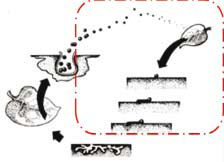 By Maurice Koome
By Maurice Koome
Description
Downy mildew is a fungal disease that causes destruction of leaves, stems, and flowers of the infected plant. Downy mildew causal organism is called Peronosporasparsa and as the scientific name indicates, the production of spores is sparse and therefore this disease is difficult to diagnose and control.
Downy mildew (Oomycete fungi) are referred to as a high risk pathogens because of the following factors;
- Oomycetes fungi are able to spread in an explosive manner under favorable conditions.
- Short development cycle (8-10 days under optimum conditions)
- High potential for reproduction (high quantities of spores)
- Wide propagation by water and wind
- Damage is not reversible: The damaged tissues die in general leading quickly to substantial losses at harvest
- High genetic variability: Rapid appearance of strains less sensitive to specifically acting fungicides possible.
Conditions for infection
The optimal conditions for the appearance of Downy Mildew are constant high humidity(RH 85-100%) low night temperatures and moisture on the leaves. The optimal temperatures for spore germination is between 10°C and 18°C no germination take place at temperatures below 5°C and the spores are killed at temperatures above 27°C.
The spores germinate within 4 hours in water, enter the leaves, and reproduce in three days. Spores survive on dried fallen leaves for as long as one month. Wet leaves and high humidity will trigger sporulation overnight. When the sun comes up, leaves start to dry, and spores are released. Most spores spread by wind and infect new leaves before noon. Six hours of constant leaf wetness is enough for spores of downy mildew fungi to germinate and infect leaves.
What factors favour these conditions ?
- Type of greenhouse
- Crop type and density
- Drip irrigation
- Nutrition status
- Human activity; prunning, scouting, spraying, harvesting etc
Downy Mildew symptoms.

- Leaves have reddishblack spots that are angular, tan spots with a very small amount of white crystalline sporulation on leaf undersides
- The leaves develop purplish red to dark brown irregular spots or blotches which might be mistaken for spray burns or possibly black spot.
- Advanced infections will have yellowing of leaves with brown necrotic areas and noticeable leaf abscission.
Disease Management
Cultural Control
- Destroy rose debris from previous crops — spores can overwinter in leaves and canes, then the downy mildew can attack new plants.
- Try to water early in the day or whenever leaves will dry quickly, to ensure dry foliage at night
- Even though fans might move spores, you should use them along with venting to reduce humidity and leaf wetness
- Hungry plants are more susceptible to downy mildew. Maintain a balanced fertility program to protect your crops
- Space plants to allow rapid drying of leaves. If the leaves are very touching, the canopy closes in and the humidity increases.
- Use resistant varieties for low maintenance plantings
Chemical Control

Choosing the most effective fungicides to prevent or eradicate rose downy mildew can be tough. Downy mildew requires a well-managed chemical spray program starting early with a rotation of chemicals for prevention. Fungicides for use against downy mildew can be categorized as either preventive, early or late curative products.
The disease also overwinters in the crop that was infected in the previous season. The fungus may overwinter in stems as dormant mycelia without oospores as shown alongside. This is the primary inoculum of the disease and upon reaching the favorable conditions, the disease infects new stems. This can be controlled through early drenching of Previcur Energy.
The preventive fungicides (mancozeb, propineb, copper compounds etc) must be applied before an infection period begins. New growth following application will not be protected.
Early curative products e.g Infinito,work against spore germination, sporangia elongation and penetration.
“Late curative products” e.g Verita, deal with intracellular infection level (by this time symptoms are visible to the eye)
- Early curative products that work against spore germination, sporangia elongation and penetration as illustrated below,

- Late curative products” that deal with intra- cellular infection level (by this time symptoms are visible to the eye) These late curative products deal with stages like Cyst germination, mycelium growth as illustrated below in the circle.

